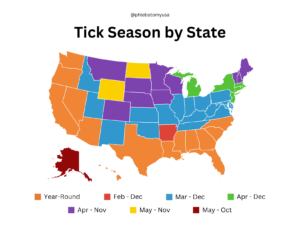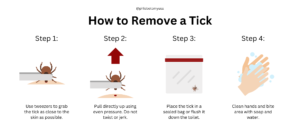
18 Sep Tick Talk: A Guide to Prevention & Safety
A tick may look small and harmless but can cause big health problems. Many people don’t realize how dangerous ticks can be. These tiny bugs aren’t just annoying; they can spread serious diseases. This is a worry for everyone, from outdoor enthusiasts to pet owners. In this guide, we’ll explore the different kinds of ticks, the illnesses they can give you, and how to protect yourself from them.
Overview
Ticks are bugs that stick to animals and people to suck their blood and grow. They are cousins to spiders and mites. Although some people believe they fly or jump, they don’t. Instead, they wait on grass or leaves with their arms out, hoping to grab onto someone passing by. When they latch on, they bite and start drinking blood. Just like mosquitoes spread diseases such as malaria, ticks, even though they’re small, can also carry and pass on serious illnesses.
Types of Ticks
North America has many different kinds of ticks. Each tick acts differently, lives in specific places, and can affect our health in various ways. Some ticks can give us serious illnesses, while others are just annoying. Let’s look at the U.S.A.’s most common ticks to help you know and recognize them.
American Dog Tick
-
- Where they live: Most of North America
- Diseases they carry: Rocky Mountain Spotted Fever, Tularemia
- What they look like: Dark reddish-brown with white markings
Black-legged Tick (Deer Tick)
-
- Where they live: The eastern United States
- Diseases they carry: Lyme Disease, Anaplasmosis, Hard Tick Relapsing Fever, Babesiosis, Ehrlichiosis, Powassan Virus
- What they look like: Very small, reddish-brown with black upper back
Brown Dog Tick
-
- Where they live: The southwestern United States
- Diseases they carry: Rocky Mountain Spotted Fever
- What they look like: Brown, turns blueish-gray when full
Gulf Coast Tick
-
- Where they live: The Atlantic coast and the Gulf of Mexico
- Diseases they carry: Rickettsia parkeri
- What they look like: Red with bright white markings
Lone Star Tick
-
- Where they live: The eastern, southeastern, and south-central United States
- Diseases they carry: Bourbon Virus, Human Ehrlichiosis, Heartland Virus, Tularemia, STARI
- What they look like: Brown with single white dot
Rocky Mountain Wood Tick
-
- Where they live: Rocky Mountain states and southwestern Canada
- Diseases they carry: Rocky Mountain Spotted Fever, Colorado Tick Fever, Tularemia
- What they look like: Bright red, teardrop-shaped body
Western Black-legged Tick
-
- Where they live: The Pacific coast of the United States
- Diseases they carry: Anaplasmosis, Lyme Disease, Hard Tick Relapsing Fever
- What they look like: Very small, reddish-brown
Diseases Ticks Carry
Ticks are more than just annoying; they can spread diseases. When they bite to drink blood, they can pass on germs that make people sick. Different ticks can give different diseases, and these can cause anything from simple rashes to serious brain problems. Knowing about these diseases can help you spot and treat them early. Let’s look at the signs of the most common tick-caused diseases in the U.S.
Anaplasmosis
Signs and Symptoms: Fever, headache, muscle pain, malaise, chills, nausea/abdominal pain, cough, confusion, rash.
Babesiosis
Signs and Symptoms: Some show no symptoms, while others might experience fever, chills, sweats, headache, body aches, loss of appetite, nausea, or fatigue.
Ehrlichiosis
Signs and Symptoms: Fever, headache, fatigue, muscle aches, and rash. Severe cases can affect the respiratory or central nervous system.
Lyme Disease
Signs and Symptoms: Fever, fatigue, headache, muscle and joint aches, and swollen lymph nodes. It can cause a circular skin rash that looks like a “bull’s eye.”
Spotted Fever Rickettsiosis (including Rocky Mountain Spotted Fever)
Signs and Symptoms: Fever, headache, abdominal pain, vomiting, and muscle pain. A rash can also appear, but not always.
Tularemia
Signs and Symptoms: Sudden fever, chills, headaches, diarrhea, muscle aches, joint pain, dry cough, and progressive weakness.
Remember, if you or someone you know starts showing any of these symptoms after a tick bite, it’s very important to see a doctor quickly. Finding and treating bites early can make all the difference.
How to Prevent Tick Bites
Ticks are small, but the diseases they carry can make us very sick. So, we shouldn’t take them lightly. The best way to stay safe from tick diseases isn’t just to treat them but to avoid getting bitten in the first place. We can keep ourselves and our families safe by preventing tick bites. Let’s learn how to protect against these sneaky bugs.
Before
-
- Awareness: Know the habitats and active seasons of ticks in your area.
- Dress Appropriately: Wear long-sleeved shirts and long pants. Light-colored clothing can make it easier to spot ticks.
- Use Repellents: Use safe insect repellents containing DEET, picaridin, or IR3535. Treat clothing and gear with permethrin.
During
-
- Stay Centered: Avoid tall grasses and bushes; walk in the center of trails when hiking.
- Routine Checks: Regularly check your clothes and body for ticks. They often go in hard-to-see areas like the armpits.
After
-
- Shower: Bathe or shower as soon as possible after coming indoors.
- Full Body Check: Check your whole body using a mirror. Examine gear and pets also.
- Tumble Dry: Tumble dry clothes on high heat for 10 minutes to kill ticks. If clothes need washing, use hot water.
How to Remove a Tick
Finding a tick on you can be scary. It’s important to take it off quickly and the right way. This helps you feel better and lowers the chance of getting sick from the tick. Even though people say you can remove ticks in many ways, not all of them work well or are safe. Make sure you use the best method to get the whole tick out safely. If you see a tick on you, stay calm and do these things:
-
-
- Use fine-tipped tweezers to grasp the tick as close to the skin’s surface as possible.
- Pull upwards with steady, even pressure. Don’t twist or jerk the tick; this can cause the mouth parts to break off.
- Submerge the tick in alcohol, place it in a sealed bag, wrap it tightly in tape, or flush it down the toilet.
- Clean the bite area and your hands thoroughly with rubbing alcohol or soap and water.
-
Conclusion
Ticks are tiny bugs, but they can make people really sick. Because they can spread diseases, it’s important to know about them and how to stay safe. We should learn about the different ticks, the diseases they carry, and how to avoid or remove them. Being careful can help us enjoy nature without worrying about these little bugs causing big problems when we’re outside.


